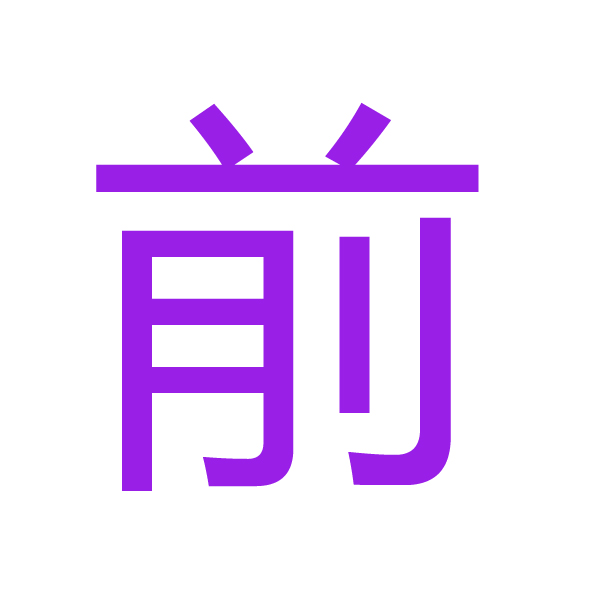
The Kanji: 前 (Mae/Zen) - The "Before" and "Front" Kanji
The kanji "前" is a fundamental character representing the concepts of "before," "front," "previous," and "in advance." It is the direct opposite of "後" (ushiro/ato - behind, after).
1. Meaning and Usage
Core Meanings: Before; in front of; previous; prior to.
Readings:
Kun'yomi (Japanese reading): まえ (mae)
On'yomi (Chinese reading): ゼン (zen)
Common Words and Compounds:
前 (まえ / mae) - Front; before
名前 (なまえ / namae) - Name
前回 (ぜんかい / zenkai) - Previous time
前進 (ぜんしん / zenshin) - Advance; forward movement
午前 (ごぜん / gozen) - Morning; a.m. (before noon)
2. Writing and Stroke Order: A Complex but Logical Structure
The correct kanji writing for "前" is complex but follows a clear left-right structure. Mastering its stroke order is essential for writing it efficiently and correctly.
Stroke Order:
The character can be broken down into two main parts: the top component 䒑 and the bottom components 月 and 刂.
Top Part (䒑):
Stroke 1: Right dot.
Stroke 2: Short horizontal stroke.
Stroke 3: Left-falling stroke.
Stroke 4: Right-falling stroke.
Bottom Part:
5. Stroke 5: Left vertical stroke of 月.
6. Stroke 6: Top horizontal and right vertical of 月 (one stroke).
7. Stroke 7: Middle horizontal stroke inside 月.
8. Stroke 8: Bottom horizontal stroke of 月.
9. Stroke 9: Vertical stroke of the 刂 (knife/saber) radical on the right.
Significance of Correct Kanji Writing:
Balance: The character has a wide, balanced structure. The left side (䒑 + 月) should be given enough width, with the knife radical (刂) neatly positioned on the far right.
Component Recognition: Understanding the components helps in memorization. The original form combined meanings related to "movement" and "a tool," which evolved into the concept of "advancing to the front."
Radical Knowledge: The right part is the "knife" radical (刂), which is crucial for the character's original meaning.
3. Historical Origin and Evolution
The history of "前" reveals a fascinating journey from a concrete action to an abstract concept of position and time.
Oracle Bone Script & Bronze Script:
The original character was "歬". It was a composite ideograph that depicted:
A foot (止) or several feet (representing movement)
A boat (舟)
The core idea was "to walk on a boat," which causes the boat to move forward. This depicted the very moment of advancement.
Seal Script:
The form underwent significant stylization. The "feet" and "boat" components became more abstract. The "knife" (刀) radical was added, possibly to represent a tool for cutting through water or obstacles, further emphasizing the idea of "moving forward."
Modern Form:
The modern "前" is a standardized form where:
The top part (䒑) is a stylized representation of the original "feet."
The 月 component is a common simplification/miscopying of the original "boat" (舟) character over time.
The 刂 (knife) radical on the right remains from the Seal Script form.
Philosophical and Cultural Connection:
"前" is deeply embedded in both the language and culture:
Punctuality: Being on time is expressed as "時間の前" (before the time).
Progress: The character is used in words like "前進" (advancement) and "向前" (forward-looking), embodying a positive attitude towards the future.
Hierarchy and Respect: In formal settings, the "前" is a position of honor. The most important person often sits at the front.
Summary
The kanji "前" is a character of movement and position. It began as a vivid depiction of feet making a boat move forward and evolved into the essential symbol for "in front" and "before." Mastering its stroke order is a key step in Japanese kanji writing, as it teaches how to manage a complex but common structural pattern. When you learn how to write kanji like "前," you are not just learning a word for "front"; you are learning a character that encapsulates the concept of advancement, priority, and the linear progression of time and space, which is central to both the language and the culture.